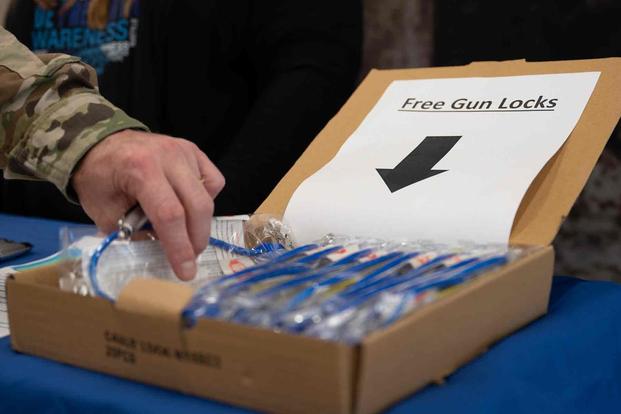The Pentagon said Thursday it will not take any actions to limit service members' access to guns and ammunition as part of its suicide prevention efforts, months after an advisory panel appointed by Defense Secretary Lloyd Austin proposed firearms restrictions to reduce deaths.
Austin signed a memo saying the department will not impose a minimum age of 25 for guns and ammo purchases or a seven-day waiting period for guns sold at military stores, which were both recommended by the advisory panel in February. It also declined to ban privately owned guns on bases or require that commanders be notified when their troops purchase a gun at base exchanges.
The decision Thursday to reject the recommendations was the culmination of a new effort by the Pentagon to finally reduce the high number of suicides, following years of policies and spending that have largely failed to curb the problem. The earlier advisory panel had pinpointed easy access to firearms, which are sold at bases across the U.S., as a top risk.
Elizabeth Foster, the executive director of the Pentagon's Office of Force Resiliency, told reporters at a press conference Thursday that the department did a very thorough review of the recommendation to raise the minimum age for on-base gun purchases to 25.
Restricting the gun sales to service members 25 years old or older would filter out younger troops who are most at risk for suicide, Austin's advisors said.
"Ultimately, we determined that there are some significant legal barriers to implementing that recommendation at this time," Foster said.
Pentagon spokeswoman Sabrina Singh said the gun-control measures are "not something we would rule out" but that the Pentagon's efforts are focused on the 111 recommendations that made the cut.
Service members, like all Americans, have Second Amendment rights to own firearms -- and they are likely to just go off base to buy them if the military imposed any on-base restrictions to buying or possessing them. Congress is also likely to make a strong challenge to any moves by the Pentagon to restrict access.
Still, the problem of guns and suicide looms over the services. The advisory panel found guns were involved in 66% of active-duty suicides, as well as 78% of National Guard suicides and 72% of reserve suicides.
On-base military exchange stores in the U.S. sold 113,200 firearms in 2021, according to figures provided to Military.com and published as part of an investigation into suicides on base. The Army and Air Force have 81 store counters that sell firearms, and the Marine Corps has 11 sites.
In February, Dr. Craig Bryan, a lethal means safety expert at Ohio State University and a member of the Suicide Prevention and Response Independent Review Committee, said the one thing all researchers agreed on was "that taking steps to slow down convenient access to highly lethal methods like firearms is the single most effective strategy for saving lives."
The Pentagon has decided to put its suicide prevention efforts into gun locks.
Dr. Timothy Hoyt, the deputy director of the Office of Force Resiliency, said the Pentagon would only incentivize the purchase of secure storage for guns in an effort to "allow service members to have the locking devices that make the most sense to them, rather than solely distributing locking devices as a department."
Various departments in each service have taken on individual programs to give away gun locks, but the impacts of those programs are unclear.
A Navy investigation into a cluster of four suicides at a Norfolk, Virginia, maintenance center found that "access to personally owned firearms, and unwillingness to surrender access to lethal means, to include the use of gun locks, was a causal factor in the deaths of all four sailors."
That Navy command handed out about 100 locks after its second suicide and more than 300 since it received them in November.
Of the full 111 recommendations that made the cut, 61 of the recommendations were also marked as "subject to the availability of funds," meaning that the department would only enact them if they have the cash. Singh said the Pentagon is hopeful that Congress "would support our efforts and provide adequate funding for what we need to implement some of these recommendations."
The full list of 111 recommendations was grouped into five "lines of effort" that were aimed at fostering a supportive environment, improving the delivery of mental health care, addressing barriers like stigmas around mental health, revising suicide prevention training and promoting a culture of safety around guns.
Austin wrote in the memo released Thursday that "we have no time to spare." However, Foster told reporters that the goal is to have all recommendations completely enacted by 2030.
"We are going to focus on implementing some of these recommendations much sooner," she said. "In an ideal world, we would have all of them implemented before that final date."
-- Konstantin Toropin can be reached at konstantin.toropin@military.com. Follow him on X at @ktoropin.
Related: Sailors Sent to a Maintenance Center Died of Suicide. The Navy Says It Wasn't Prepared to Help Them.











